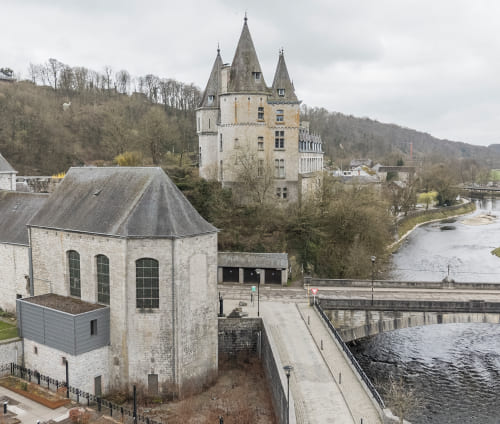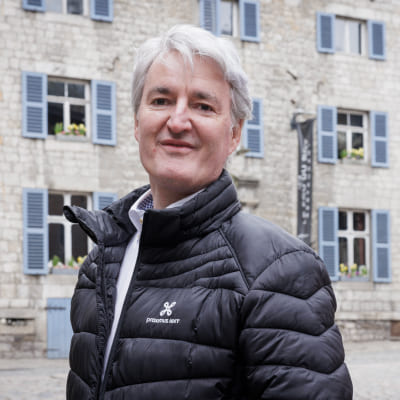Ensuring health and mobility in Durbuy thanks to 5G
Published on 16/04/2025 in Customer talks
AWLabs, Proximus NXT, and other IT partners are conducting a 5G proof of concept (PoC) in e-health. Based on air and noise pollution data collected via 5G, Durbuy is receiving public health and mobility recommendations.

In brief:
- 5G proof of concept in e-health to reduce noise and air pollution
- Collective strength: each consortium member contributes its own expertise
- Leveraging data with a visual interface
- 5G reliability, stability, and coverage
- Smoother mobility in Durbuy backed up by data
- Impact on public health and data availability

With its 44 villages and hamlets, including Durbuy Old City, the municipality of Durbuy draws more tourists than any other in Wallonia. On weekends and in the summer, its population increases from 11,500 to 30,000.
Challenges faced by Durbuy
Durbuy attracts large numbers of tourists and visitors every year. While the economic benefits are substantial, this influx of tourists has some drawbacks for the authorities and local residents:
- Traffic congestion
- Parking problems
- Noise pollution caused by cars and motorcycles exceeding the permitted decibel limits.
5G proof of concept in e-health
In June 2023, Wallonia’s Digital Agency launched a second call for 5G proof of concept projects, in collaboration with the Walloon Public Service for Economy, Employment, and Research. In response, a consortium formed by AWLabs, Proximus NXT, Multitel, and CeRD ECAM successfully submitted the GROOVE (5G air and sound improvement) project.
5G: versatile
“This call for projects under the Giga Region program aims to develop new use cases based on 5G-driven research,” explains Cécile Noël, Senior Expert in ultra-high-speed connectivity at the Digital Agency and head of the Giga Region program. “GROOVE is our first project in e-health. We wanted to show that 5G is also useful in applications directly related to health.”
Groove is our first project in e-health. We wanted to show that 5G is useful in fields other than the industry of the future.
Cécile Noël, Senior Expert in ultra-high-speed connectivity at the Digital Agency
Use cases in Durbuy and at A6K
In this 5G proof of concept project, sensors measure air quality and noise pollution in urban and rural settings. The collected information is transmitted via 5G and then analyzed in order to make recommendations, in particular on public health, mobility, and urban planning. The consortium has implemented use cases in Durbuy old city via the Proximus public 5G network, and in Charleroi in the indoor setting of A6K via a private 5G network.









Extending the network of sensors
“There’s been an air quality measurement network in all cities since the 1970s,” explains Michaël Balbaert, CEO of AWLabs. “We wanted to see if extending the network would make it possible to detect other issues not measured by the current sensor network. The Wallonia Recovery Plan subsidy made available through the Digital Agenda project covers part of the development budget. The PoC wouldn’t have been possible without this financial support.”
This PoC shows that Proximus 5G, private or public, ensures reliable and high-performance data transmission.
Frédéric Renette, 5G Business Development Lead at Proximus NXT
A collective approach
Coordination and data analysis
As the project initiator, AWLabs has acted as coordinator, for example by arranging regular meetings with all consortium members. Furthermore, the startup has used CFD (computational fluid dynamics) technology to position the sensors optimally using a LiDAR scanner.
Once these measuring devices were installed, AWLabs started collecting and analyzing the data based on an internally developed predictive model. It then generated a report for the Mayor of Durbuy on improving his city’s well-being and development. A user-friendly dashboard makes it easy for users to view the information.

Public and private 5G networks
As well as providing the public 5G network, Proximus NXT validated the sensor installation locations with the city of Durbuy and other partners. It also used the A6K ecosystem to co-create, collaborate, and test the solution on a private 5G network.
“The same solution can be used to measure indoor pollution, as demonstrated by the experiment conducted on A6K’s private 5G network,” confirms Frédéric Renette, 5G Business Development Lead at Proximus NXT.
Developing the measuring devices
Technology development experts Multitel designed the 5G modem that sends data over the network, and integrated it into the sensors developed by CeRD-ECAM. Developing these noise and air pollution measuring devices proved to be a real technological challenge.
“Integrating a 5G modem into a perfectly sealed box that operates within relatively wide temperature ranges was no easy task,” acknowledges Stéphane Deketelaere, Head of Signal & Embedded Systems Department at Multitel.
5G’s low latency, controlled transfer times, and very high data speeds are particularly suited to transporting sound data in real time.
Stéphane Deketelaere, Head of Signal & Embedded Systems Department at Multitel
Visual interface
“In any project involving data collection, leveraging that data is essential. For everyone to benefit from the data, they must be able to use and understand it,” emphasizes Frédéric.

On the dashboard created by AWLabs, users can view pollution levels on an interactive 3D map. By clicking on any data collection point, they can access a visual with colored gauges linked in particular to the Belgian air quality index (BelAQI), a histogram, graphs, and an insert showing the recommendations of the AWLabs experts.
Our research relies on real-time data to track pollution spikes — 5G provides the needed speed and stability.
Michaël Balbaert, CEO at AWLabs
Real-time data processing thanks to 5G
To allow accurate maps to be presented, in particular so as to analyze the impact of a road at a specific location, the impact of gusts of wind, or the presence of factories, a large amount of data passes through the network.
“Our scientific approach requires real-time data processing to draw attention to pollution spikes and determine their causes. The 5G network’s bandwidth, stability, and reliability are essential,” explains Michaël.
The 5G network’s reliability and stability
“Because noise is highly changeable, it generates a large amount of data. 5G’s low latency, controlled transfer times, and very high data speeds are particularly suited to transporting sound data in real time,” adds Stéphane.
“The 5G network is a new mobile technology for data transmission,” confirms Frédéric. “In addition to its reliability and stability, it offers increasingly wide coverage. By the end of 2024, it covered nearly 75% of the Belgian population.”
Elements measured
- Air quality:
- fine particles from road traffic, heating, biomass combustion, urban activities, urban dust, traffic, construction activities, etc.
- combustion gases (vehicles, heating, industry, etc.)
- organic compounds from cleaning products, building materials, etc.
- Noise pollution: decibels and anonymized sound signatures
- Standard measurements: temperature, relative humidity, atmospheric pressure, and CO2
Although it’s new, this technology could affect certain decisions which will ultimately move us towards a pedestrianized and less polluted Durbuy.
Patrick Bultot, Alderman for Mobility in Durbuy
Improving mobility in Durbuy Old City
Faced with parking, traffic, and noise pollution problems, Philippe Bontemps, Mayor of Durbuy, welcomes the experiment in which his city is participating. “We’ve definitely observed pollution peaks on the graphs during busy periods,” the Mayor explains. “Drivers sometimes have to circle the old city several times before finding a parking space. These pollution peaks can affect the health of local residents,” adds Patrick Bultot, Alderman for Mobility.
Input for lobbying activity
“This confirms the need to increase peripheral parking so that tourists don’t need to drive into the city center. We’ve anticipated this with one car park to the south and another to the north,” explains Philippe. “I’m currently lobbying the relevant minister for a bridge that will provide direct access to the car park. The data from the GROOVE project is potentially an additional persuasive piece of evidence that will move this issue forward,” he says.

Emergence of new trends
“The sensors are showing trends that no one has measured before. We’re analyzing them in order to understand where the pollution peaks are and consider improvements,” adds the Alderman for Mobility. “This new technology could affect certain decisions which will ultimately move us towards a pedestrianized and less polluted Durbuy.”
Durbuy: a smart city
According to Michaël, the local authorities are the main beneficiaries of this PoC: “They can see the concentrations of pollutants due to airflow in particular locations and then make informed decisions. Furthermore, the increased coverage offers a level of precision that exists nowhere else in Wallonia at the moment. With five sensors, Durbuy is the smart city with the densest coverage.”
The data collected will allow us to argue the need for peripheral car parks.
Philippe Bontemps, Mayor of Durbuy
What does the future hold?
Impact on public health
The consortium members intend to expand the PoC by going further in terms of industrialization and sizing, and by targeting larger-scale use. “Intelligent pollutant management can have an impact on public health,” emphasizes Michaël. “By following the recommendations, a municipality can expect to reduce the risk of respiratory and cardiovascular diseases associated with air pollution. Cutting down on noise pollution can also improve the well-being of citizens and visitors.”
An objective basis for decisions
“This project brings real value to cities and municipalities by helping them make objective decisions. They can also provide relevant information to the general public in a form that is very easy to understand,” adds Frédéric.
The City of Durbuy agrees. The Mayor plans to continue the experiment beyond the GROOVE project’s test phase: “I’m interested in air pollution, but noise pollution is equally important. Quantifying noise pollution provides an additional reason for keeping the sensors in the city and possibly re-assessing their locations.”
Publicly available data
“Furthermore, we intend to make this data available online in the ‘Durbuy en poche’ app. Air pollution is an invisible poison, unlike noise pollution, which everyone can hear.” As the GROOVE solution also allows sound signatures to be recorded, the Mayor hopes that fines can eventually be handed out for noise pollution, just as they are for speeding.
“Ultimately, anyone who earns a living directly or indirectly from commerce will welcome having a city that’s easier to access and pedestrianized,” he concludes.
GROOVE partners
- AWLabs, a research laboratory specializing in the management of in- and outdoor air quality and noise pollutants.
- Multitel, an accredited research center for digital technology innovation that benefits the Walloon ecosystem.
- CeRD ECAM, a university research center that supports and assists research, development, and innovation in engineering.
- The Digital Agency, an open, innovative, and neutral organization recognized as a catalyst for the region’s digital transformation, a center of expertise and a key advisor to the Walloon Government and Wallonia.
- A6K, an ecosystem bringing together industrial leaders, startups, universities, institutional stakeholders, and research centers to stimulate innovation in the field of engineering.
- The City of Durbuy, Wallonia’s leading municipality for tourism.
- Proximus NXT, a supplier of telecom and IT solutions and services for digital transformation.

What can 5G bring to your business?
5G technology is revolutionizing industries with ultra-fast, high-performance connectivity and enhanced security. Make the most of new opportunities, improve your efficiency, and take the lead in a fast-changing digital world.



